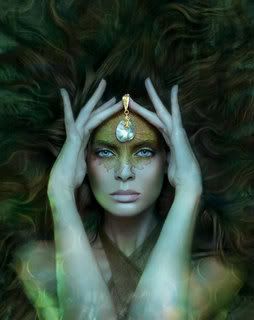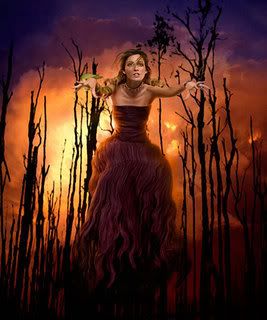There are scents which are comforting, snuggly like an old favourite jumper when the sky is uninviting, first thing in the morning, and the temperatures are plummeting; a fragrance which smiles at you from within its heavy glass with the sweetness of a kid on a Hallmark card. And there are scents which are devilishly playing tricks on you, requiring that you have either the right attitude or the right weather conditions or the just right outfit (and possibly makeup and jewellery too!) in order to bring out their best; if they want to! But oh, when they do...The latter category might seem like they're ultimately a pain in the butt to have around (what if you look at them in a certain way and they crack from side to side?), but so often they form some of the most satisfying fragrances we possess in our wardrobe. The former... well, they are our fall-back-upon scents and in times like this, this is kinda precious too, don't you agree?
So here is our small selection of "Tricksters and Treaters". Feel free to add yours in the comments!

• THE TRICKSTERS
À Travers le Miroir by Thierry Mugler
A strange tuberose, half-way between carnivorous mentholated flower with bitter touches (reminiscent of a herbal autumn garden) and decaying sweet flesh; yet rather light, if you can imagine that! If you're a man and always wanted to own a tuberose fragrance but found them too Fracas-shouting femme, then this is your bet. Alexis Dadier must be a brave perfumer since he shed tuberose of its black lingerie & berry lipstick to reveal its muscled up (hold the baby oil!) facets. A tuberose of the Tubéreuse Criminelle school of thought!
La Myrrhe by Serge Lutens
Myrrh gum is part of ecclesiastical incense alongside frankincense for millenia. You would expect an oriental, full of resinous mystery, going by the name, right? Lutens goes one better and infuses the bitter ambience of myrrh with candied mandarin rind and citrusy aldehydes which bring this on the upper plane of an airy aldehydic. Somehow it wears lightly but solemnly too and it resembles nothing else on the market. Cool autumn days bring La Myrrhe's attibutes to the fore and it remains amongst my most precious possessions.
Aromatics Elixir by Clinique
It's hard to picture autumn without the imagery of a forest in full regalia, evergreens gaining inches day by day, sepia foliage being trampled underfoot and the promise of fairies in the wings; sorry, behind the mighty oaks, I meant to say... The enchanted forest scentscape of Bernand Chant's masterpiece is among the most challenging, but also among the most complimented and revered, fragrances in the world. If you find difficult to tame this patchouli, rose & oakmoss Godzilla accord in the pure parfum spray, tone it down opting for the Eau de Toilette or Velvet Sheer formulation within the range. Review of Aromatics Elixir on this page and smell-alike on that one.
No.18 by Chanel Les Exclusifs
If you're lucky enough to have this ambrette and rose blend sing on your skin, you're very fortunate. I wish it did on mine and in my memory banks as well. It's probably among the most individual things to come out in the last 10 years and it's quite unique (Although Musc Nomade isn't too far removed in its concept, but the Chanel is more of a subtle perfume than an invisible human aura like the Goutal). Review of No.18 here.
Les Larmes Sacrées de Thèbes by Baccarat
If only because this discontinued limited edition Egyptian beauty will have you scouring the Internet for it but end up paying through the nose (Masochists, please take note! I actually managed to bypass this at a Baccarat boutique when it was available commercially). Somnombulent balsams speek of Egyptian rituals which transport you to a warmer, southern meridian. (Read reviews of all three Baccarat scents for the occasion on this link)
• THE TREATERS
Doblis by Hermès
Doblis is an anomaly: Such a refined composition, the best leather fragrance in the world (and the rarest) just can't be classified in the treaters, where sweet ambers and indulgent gourmands should populate the premises, could it? And yet, Doblis is so silken, so restrained, so smooth, fanning precious flowers onto the most buttery suede, that it transcends into the beatific ecstacy reserved for true excellence. Review of Doblis on this page.
Like This by Etat Libre d'Orange
And the anomalies continue: What is an Etat Libre scent doing in this side of the list? But its welcoming spicy notes of immortelle and ginger and its succulent pumpkin and mandarin heart, set nevertheless in an interesting diorama where one supercedes the other, Like This reads like wise verse by Rumi instead of a Dear Abby column as one would expect; and on top of that it is fronted by the most interesting celebrity to front a fragrance in the last -oh- twenty years...Tilda Swinton! More info on this link.
Shalimar Ode à la Vanille by Guerlain
The smoothness and delicacy of vanilla pods, air-spun here and with a prolonged and rather linear, easy projection of citrus and familiar core. Impossible not to like, impossible to misbehave. More info on this article.
Bois et Musc by Serge Lutens
Autumn can't be autumn without the evocation of woods and this small gem in the Palais Royal Parisian exclusive line by Lutens fulfills the bill admirably, because it highlights both the woody panel of cedar and the skinscent idea of a humane-smelling musk. Simple but very effective and drop-dead sexy. Review of Bois et Musc here.
Coromandel by Chanel Les Exclusifs
Dusty cocoa and refined patchouli to the point that it reads as devoré velvet in shades of deep maroon. Justifiably it's the best-seller in the newer Les Exclusifs (alongside less character-driven, more camel coat & low pumps scent of Beige). Review of Coromandel here.
Related reading on Perfume Shrine: Comforting scents for when the Going Gets Tough, Falling in Love: Scents & Treats for Fall
Photography by Fred Boissonas in early 20th century Greece: a) Edessa 1908 and b) Kastoria Kleisoura manor 1911.
.jpg)


















.jpg)

.bmp)
.jpg)
.jpg)
.jpg)







